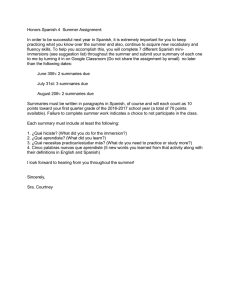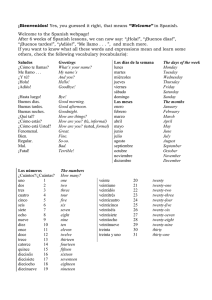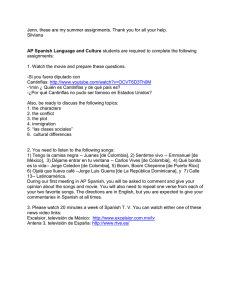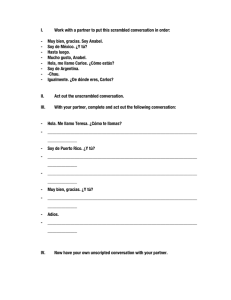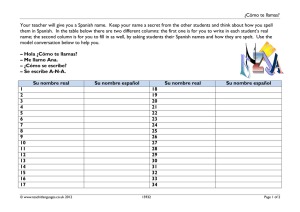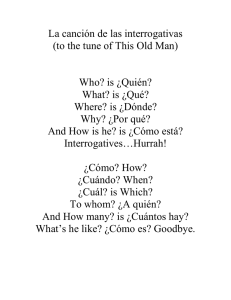Chapter One - Kendall Hunt
Anuncio
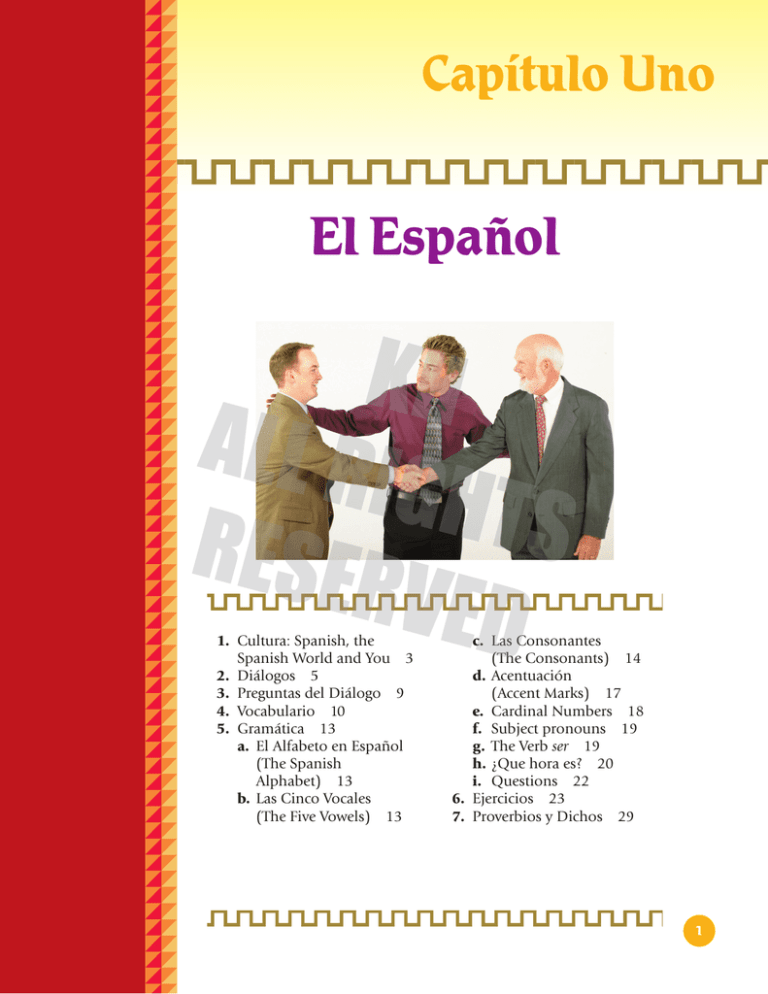
Capítulo Uno El Español 1. Cultura: Spanish, the Spanish World and You 3 2. Diálogos 5 3. Preguntas del Diálogo 9 4. Vocabulario 10 5. Gramática 13 a. El Alfabeto en Español (The Spanish Alphabet) 13 b. Las Cinco Vocales (The Five Vowels) 13 c. Las Consonantes (The Consonants) 14 d. Acentuación (Accent Marks) 17 e. Cardinal Numbers 18 f. Subject pronouns 19 g. The Verb ser 19 h. ¿Que hora es? 20 i. Questions 22 6. Ejercicios 23 7. Proverbios y Dichos 29 1 Cultura Spanish, the Spanish World and You You are studying Spanish because it is a very important language from a political, economic, and cultural perspective. It is one of the most spoken languages in the World. Spanish is spoken by about 500 million native speakers and by an even larger number of people who speak it as a second language or as a foreign language. There are approximately about 50 million Spanish speaking people in the United States. It is spoken in Europe, Africa, Asia, North America and South America. It is even spoken in Antarctica where Chile and Argentina claim territorial sovereignty, maintaining research and military stations there. Spanish is also important from a business perspective as Spanish speakers are one of the best consumers of American products. Latin American countries are also very rich in natural resources of all different types. For example, most of U S imported oil comes from Spanish countries not from the Middle East, as many Americans erroneously think. Spanish culture with its millennial traditions in the arts, sciences, music, literature, sports, cuisine, fashion, and every human endeavor will enrich your life as you learn more about it and the language you are starting to learn. The Spanish world is known for its great diversity. It is so diverse that some people question its very identity. Is it a linguistic unit?—Is it an ethnic group, a people, a race, 3 4 CHAPTER 1 a nation?—It is difficult to define because it defies any definition. Many Spaniards question the very notion of Spain, as many Latin Americans question the very notion of the terms Latin American, Hispanic, or Latino. Let’s review the facts and you can come up with your own definition. The Iberian Peninsula was inhabited about 35,000 years ago by the first Europeans. We do not know whether they came from North Africa or from Asia Minor. During the last glacial age about 15,000 years ago, most northern Europeans took refuge in Spain. The first Iberians were followed by the Celts, Greeks, Phoenicians, Carthaginians, Romans, Jews, Germanic tribes, Moors, Arabs, Syrians, and Gypsies. Although there was extensive intermarriage, some of these groups ended up more isolated than others in a very mountainous area. Therefore, people in some areas developed their own language, customs, and identity. Thus, there are millions of Spaniards who are bilingual and whose second language is Spanish. When the Spaniards conquered parts of Africa, Asia, and the Americas, they found wellestablished civilizations that had developed different languages and customs. Therefore, there are countries such as Peru where many people speak Quechua as their first language and Spanish as a second language. The same is true of Paraguay where many people speak two languages, Guarani and Spanish. There are also Spanish countries where there are many people who do not speak Spanish. That is the case of Mexico. The Spaniards were in the Philippines for 400 years. They left their language, their religion, and their customs. However, nowadays, Tagalog replaced Spanish as the first language in the Philippines. Millions of immigrants flocked to Latin America during the nineteenth century from countries as diverse as Japan, China, Lebanon, Italy, Germany, Ireland, Wales, Russia, and Eastern Europe. They brought their customs and their language. Most of them integrated into the Latin America melting pot; others preferred to remain separated, preserving their language and customs. There were Welch, German, Scottish, Croatian, Japanese, and many other communities in many parts of Latin America. The big influx of African slaves to the Spanish colonies came during the nineteenth century as well. They were brought primarily to the Caribbean area to harvest sugar and other crops. Some of them ran away, forming their own communities; others were integrated into the new nations forged out of former Spanish colonies. Three quarters of the land of the continental United States was once Spanish territory. Such American legends as Daniel Boone, Sam Austin, and Admiral David Farragut are part of that heritage. Geographically as well, the Spanish world extends from places of perennial snow in Antarctica to tropical paradises in the Caribbean or the Pacific Ocean, from places where it never rains in North Africa or South America, to places where it always rains in northern Spain or Southern Chile. Can you now define that which is Hispanic? Diálogos Lea y repita los siguientes diálogos. Trate de imitar estos diálogos. Practique los diálogos sin leer el libro, con un compañero de clase El professor Pacheco se presenta a su nueva clase de español. El profesor Pacheco – Muy buenos días. Soy el Profesor Pacheco. Soy de Chile, soy chileno. Esta es la clase de español elemental. El libro que usamos es “Yo soy así”. Es un libro interesante y práctico. Ahora quiero saber quién es usted. 5 6 CHAPTER 1 Los estudiantes se presentan al profesor Pacheco. - Buenos días, profesor Pacheco, yo soy Sofía y soy de New Jersey. - Yo soy Miguel y éste es mi amigo Daniel, somos de California. - Yo soy Raquel y soy de New York. - Yo soy Samuel y soy del Canadá. Los estudiantes se presentan y se conocen en la clase. Sofía—Hola, buenos días, me llamo Sofía, y tú. ¿Cómo te llamas? Arturo—Buenos días. Yo me llamo Arturo. Mucho gusto. Sofia—Encantada. ¿De dónde eres? Arturo—Soy de Michigan, y tú. Sofía—Yo soy de New Jersey. Luisa—Hola que tal. Yo soy Luisa y éste es mi amigo David. Mateo—Hola Luisa, Yo soy Mateo. Mucho gusto. David—El gusto es mío. Más Diálogos Una Llamada Telefónica Begoña—Hola, Pepe, ¿Qué tal? ¿Cómo estás? Pepe—Muy bien, ¿Qué tal? ¿y tú? Begoña—Muy bien. Soy estudiante del profesor Pacheco. ¿y tú? Pepe—Soy estudiante del Profesor Pacheco tambien. Begoña—Sí, él es muy simpático. Pepe—Sí, y muy inteligente también. En el Aeropuerto Policía—Su nombre, por favor. Turista—Yo soy José Pacheco López. Policia—¿Nacionalidad? Turista—Yo soy Chileno 7 8 CHAPTER 1 Policia—¿Destino? Turista—Río de Janeiro, Brasil Policia—Gracias, buen viaje. Turista—De nada, adiós. Preguntas del Diálogo Piense, Pregunte y Conteste 1. ¿Cómo se llama el profesor? 2. ¿Cómo se llama el libro? 3. ¿Es de noche/ por la mañana/ por la tarde? (In Arturo’s dialogue) 4. ¿Cómo se llama el doctor? 5. ¿Qué clase es? 9 Vocabulario * De Lecturas Expresiones de Saludo When greeting people we often use the following expressions: Hola Buenos días Buenas tardes Buenas noches Hello, Hi Good morning Good afternoon Good evening Good night Expresiones de Despedida When saying “goodbye” we may use the following expressions: Adiós Hasta pronto Hasta luego Hasta mañana Chao Hasta la vista Goodbye See you soon See you later See you tomorrow Chao See you around Otras Expresiones ¿Qué tal? ¿Cómo estás? ¿Cómo está usted? (Muy) bien (Muy) mal Excelente Terrible Así así Mucho gusto/un placer Encantado(a) El gusto es mío Gracias 10 What’s up? How are you? How are you? (Very) well (Very) bad Excellent Terrible So so My pleasure Delighted The pleasure is mine Thank you El Español De nada No hay de qué You’re welcome You’re welcome Cognados One way of increasing your vocabulary in Spanish is by using cognates—words in different languages, having similar meanings, with the same linguistic root. Study the following groups of cognates and then add other words to the lists. Words ending in –or actor calculador color doctor factor moderador motor profesor radiador regulador tractor Words ending in –sión admisión decisión mansión misión omisión pasión televisión tensión visión Words ending in –al actual canal carnal casual lineal manual marcial parcial potencial puntual sensual visual Words ending in –ción atracción contracción dirección elección lección producción reacción relación traducción 11 12 CHAPTER 1 Cognados Words ending in –dad Words ending in –able Calidad Cantidad Ciudad Generalidad Libertad Movilidad Personalidad Universidad Vecindad aconsejable amable disponible favorable probable soluble Adjetivos terminados en E 1. amable 2. independiente 3. imprudente 4. prudente 5. agradable 6. inteligente 7. paciente 8. impaciente 9. importante 10. brillante 11. sociable 12. dominante 13. elegante 14. variable 15. cobarde 16. valiente 17. humilde 18. Insoportable 19. alegre 20. amigable 21. competente 22. responsable Adjetivos terminados en Z 1. feliz 2. capaz 3. tenaz 4. audaz 5. veloz 6. eficaz 7. sagaz Adjetivos acabados en l 1. sentimental 2. especial 3. juvenil 4. vil 5. imbécil 6. fácil 7. difícil 8. frágil 9. volátil 10. sutil 11. vital 12. fácil 13. difícil 14. frágil 15. volátil 16. sutil 17. musical 18. genial 19. leal 20. cruel Gramática El Alfabeto en Español (The Spanish Alphabet) Las Cinco Vocales (The Five Vowels) The sounds of the vowels in Spanish are crisper and shorter than the sounds produced in the English language. Each vowel produces only one distinguishable sound and when a syllable contains a diphthong, each vowel is pronounced independently from the other. Imitate carefully the sounds of the vowels in Spanish: a as in father Ana mamá sala ama e as in net Elena Pepe peso tele 13 14 CHAPTER 1 i as in see Inés Pili sí siglo o as in no Paco no dos dónde u as in ruler Rufo ruso Cuba tú When a weak vowel (I and U) and a strong vowel (A, E, and O) are used in the same syllable, the natural phonetic emphasis falls on the strong vowel. There is no need to use an accent mark: Alicia seis nueve cuatro agua siete biblioteca Lourdes Miami When two weak vowels form a diphthong, the emphasis falls on the second vowel: Luisa viudo fui When two vowels follow each other, an accent mark is used to break the diphthong: Sofía García Las Consonantes (The Consonants) There are twenty-two consonants in the Spanish alphabet (one more consonant than in the English alphabet). b c d f g (be) (ce) (de) (efe) (ge) h j k l m (hache) (jota) (ca) (ele) (eme) n ñ p q r (ene) (eñe) (pe) (cu) (ere) s t v w x y z (ese) (te) (ve) (uve doble) (equis) (i griega)* (zeta) *The y also functions as a vowel when it is found at the end of a word, having the same sound as the vowel i, such as: muy. The phonetic sounds of most consonants in Spanish produce the same sound as those in the English language. The consonants l, f, p, m, n, t, and s have similar sounds; however, a breath of air as in English does not accompany the p and t consonants: lata monta notable tomate patos fotos El Español The d, although resembling the English d, is pronounced harder when found at the beginning of a word, and somewhat softer in a middle of a word: Diego dame domingo desatar disco nudo candidato capacidad emotivo inodoro There are other variations of the d depending on the regions where the language is spoken. For example, it is common to pronounce a final d similar to a th sound in areas of Spain. Thus, madrileños (residents of Madrid) may be heard saying “Madrith.” Likewise, in other areas, the sound of the final d may be silent and now becomes “Madrí.” The ñ, the extra consonant, produces a sound similar to the English words onion and canyon. The sound is reminiscent of the French -gn combination: caña cañada caño cañería Ñico The h is never pronounced in Spanish: hola alcohol hablo Humberto The words hola and ola, although having different meanings, are pronounced the same. The j takes the English sound of the h: jamón jerez jinete jornada Julio The c and the g consonants have two distinct sounds, depending on the immediate vowel following them in a syllable. With the vowels (a, o, or u) they produce the same hard sound as in English: casa cola Cuzco concha cubo gallo gota gusto goma gato When followed by the vowels (e or i) the c produces the same sound as the s: cero cielo celos cifra cilantro In certain areas of Spain, in particular the northern regions, the c is pronounced similar to a soft th sound in English. Likewise the th sound is found in the -za, -zo, or -zu combinations in the same areas of Spain. The z is never used with the vowels e or i. Thus the plural of luz becomes luces. The letter k, although included in the Spanish alphabet, is only used with words borrowed from other languages. To attain the English k sound with the vowels e or i, remember to use the -que or -qui combination: Quito or queso. It is then possible to achieve the hard c sound this way: ca que qui co cu. 15 16 CHAPTER 1 The g has the same sound as the English h when it is followed by the vowels (e or i). It is similar to the j sound: gente gitano jefe jirafa However, the vowel u is not pronounced if found between the g and the vowels e or i. In this case the g has a hard sound, similar to the (ga, go, or gu) combinations: guerra guitarra Then, it is possible to achieve the hard g sound with all five vowels: ga gue gui go gu If the u carries the diérisis ü in the same combination of letters, then it is pronounced independently, similar to the sound –gua in the words agua, aguacate, or guacamole: Güines nicaragüense cigüeña cigüeñal The letters b and v have similar sounds in Spanish. Their sound is closer to the English b. There is no phonetic difference between the following words: bacalao Benito bingo bonito burro vaca venado vino volar vulgar Until recently the Spanish alphabet included the following consonants: ch, ll, and rr. Although they are still used in Spanish, they are merely considered double consonants. The sound produced by the combination ch is found in words like cha cha cha, che, chino. The ll is pronounced like the y in most parts of the Spanish-speaking world. Thus the words gallo, gallina, and gallego are pronounced similar to the words yanqui, yerba, and yo. The rr combination is pronounced as a trilled sound and is never found at the beginning of a word or after the consonant n. The sound of the r is equally strong when found as the initial letter in a word; thus, ferrocarril, cigarro, perrito, refresco, Roberto, and Enrique have similar rr or r sounds. If the consonant r is used within a word, then it carries a weaker-trilled sound, as in the words: María, arena, parabrisa, and morena. The letter w has limited uses. Just like the k, it is used in commonly non-Spanish words: whisky, windsurf, waterpolo, Walkman, among others. El Español The x is pronounced similar to the English x if found between two vowels. If it is followed by a consonant, it is often pronounced like an s: examen próximo exacto extraordinario expedición explosión Acentuación (Accent Marks) Not all words in Spanish need an accent mark or tilde! Generally, the accent mark denotes the phonetic emphasis on a given syllable if the word does not follow the natural stress on that particular syllable. In other words, an accent mark expresses an exception to the following rules. Words ending in any of the five vowels or the consonants n or s carry the stress on the next to the last syllable: muchacho Elena elefante caqui Carmen muchachos All other words ending in a consonant (except n or s) are stressed on the last syllable: roncar aptitud Brasil frijol Internet Then, if a word carries the stress on a different syllable, it must show the accent mark on the vowel of the syllable that is stressed: inglés glándula pájaro glotón clímax All words in Spanish that are stressed on the third (esdrújulas) or fourth (sobresdrújulas) syllables must be written with an accent mark: Cuéntamelo centímetro cláusula lámpara entrégaselo There is a final use of the tilde or accent mark. Certain words have the same spelling, but have different meanings. Then, an accent mark is used to differentiate their meanings: él ⫽ he tú ⫽ you sí ⫽ yes más ⫽ more sólo ⫽ only aún ⫽ moreover té ⫽ tea el ⫽ the tu ⫽ your si ⫽ if mas ⫽ but solo ⫽ alone aun ⫽ even te ⫽ you (object pronoun) 17 18 CHAPTER 1 Cardinal Numbers 0 cero 20 veinte 1 uno 21 veinte y uno (veintiuno) 2 dos 22 veinte y dos (veintidos) 3 tres 23 veinte y tres (veintitres) 4 cuatro 24 veinte y cuatro (veinticuatro) 5 cinco 25 veinte y cinco (veinticinco) 6 seis 26 veinte y seis (veintiseis) 7 siete 27 veinte y siete (veintisiete) 8 ocho 28 veinte y ocho (veintiocho) 9 nueve 29 veinte y nueve (veintinueve) 10 diez 30 treinta 11 once 31 treinta y uno (una) 12 doce 40 cuarenta 13 trece 50 cincuenta 14 catorce 60 sesenta 15 quince 70 setenta 16 diez y seis (dieciséis) 80 ochenta 17 diez y siete (diecisiete) 90 noventa 18 diez y ocho (dieciocho) 19 diez y nueve (diecinueve) El Español Subject Pronouns Singular Plural Yo, I Tú, You (fam.) Usted, You (pol.) El, he Ella, she Nosotros (as), We Vosotros (as), (fam.) Ustedes, You (pol.) Ellos, They (masc./mix) Ellas, They (fem.) The English subject pronoun it has no counterpart in Spanish; it is understood. Es una clase muy interesante. It is an interesting class. The Verb Ser Spanish uses two verbs to express “to be.” Although these verbs have specific uses and can’t be interchangeable, we will only learn the verb “ser” in this unit. The present tense of “ser” is irregular, and it must be learned by itself. Ser Yo soy Tú eres Él, Ella es Usted Ser Nosotros/as Vosotros/as Ellos/as Ustedes Somos Sois Son 1. Ser is used to identify the subject. Yo soy Roberto Sandoval. Ella es Teresa Molina. 2. Ser describes characteristics that are viewed as inherent qualities of the subject. Mi hermano es simpático y divertido. Teresa Molina es muy estudiosa. 3. Ser states origin and nationality. El Doctor Blanco es de Cuba. Él es cubano. 19 20 CHAPTER 1 4. Ser is also used to tell time and to express dates. ¿Qué hora es? Son las dos de la tarde. Hoy es el 22 de noviembre. What time is it? It is two o’clock in the afternoon. Today is the 22nd of November. 5. With the preposition de to express ownership and to indicate what things are made of. El carro no es de Teresa; es de Carlos. It is not Teresa’s car; it is Carlos’. La casa de los González no es de madera; es de adobe. The González’s house is not (made of) wood; it is made of adobe. 6. To form impersonal expressions like: es necesario, es importante, es imposible, es probable, and so on. Es necesario estudiar para sacar buenas notas. It is necessary to study in order to get good grades. Es importante hablar español en la clase. It is important to speak Spanish in class. ¿Qué hora es? Las horas del día In order to ask “What time is it?”, Spanish uses the expression: ¿Qué hora es? To respond, use “Es la + time” when the hour is “una” (one). Es la una de la tarde. Es la una y uno de la mañana. It is 1:00 P.M. It is 1:01 A.M. Notice that the hour one is feminine (una), while the minute one is masculine (uno). Use “y” to separate hours and minutes. El Español Use “Son las + time” when the hour is higher than one. Son las dos de la tarde. It is 2:00 P.M. Son las nueve y cuarenta y cinco de la mañana. It is 9:45 A.M. Son las doce y cuarto de la tarde. It is 12:15 P.M. Son las cuatro en punto. It is exactly 4:00. Use “media” to express 1⁄2 past the hour, and “cuarto” to express 1⁄4 past the hour. Son las siete y media de la mañana. It is 7:30 A.M. Es la una y cuarto de la tarde. It is 1:15 P.M. (the use of the articles el, la is optional) Noon may also be expressed as “Es el mediodía”. Midnight as “Es la medianoche”. To express the minutes after the half hour subtract the minutes left until the next hour. Instead of using “y”, use “menos”. For example: Son las once y cincuenta de la noche. It is 11:50 P.M. Son las doce menos diez. It is 10 minutes until 12. Es la una y cincuenta y cinco. It is 1:55. Son las dos menos cinco. It is 5 minutes to 2. A. State the appropriate greeting depending on the given time: Buenos días, Buenas tardes, or Buenas noches. 1. 8:05 P.M. 2. 12:15 P.M. 3. 10:00 A.M. 4. 4:00 P.M. 5. 11:25 A.M. 6. 7:30 P.M. 7. 1:00 A.M. 8. 9. 12:00 A.M. 1:00 P.M. B. Give the correct time for the following items. 1. 5:15 P.M. 2. 11:20 A.M. 3. 1:40 P.M. 4. 6:55 A.M. 5. 7:00 P.M. 6. 1:00 P.M. 7. 8:30 A.M. 8. 4:45 P.M. 9. 12:00 A.M. 10. 3:30 P.M. 11. 10:15 A.M. 12. 12:00 P.M. 21 22 CHAPTER 1 Questions Including an interrogative pronoun that specifically asks for some type of information may also form questions. The most common question words are: ¿Qué? ¿Por qué? ¿Quién(es)? ¿Con quién(es)? ¿Para quién(es) ¿Cómo? ¿Cuál(es)? ¿Dónde? ¿Adónde? ¿De dónde? ¿Cuándo? ¿Cuánto(a)? ¿Cuántos (as) What? Why? Who? With whom? For whom? How? / What like? What? / Which? Where? Where to? From where? When? How much? How many? Placing the interrogative pronoun first followed by the verb and then by other words in the question is the standard syntax. ¿Quién enseña la clase de español? ¿Dónde trabaja él? Who teaches the Spanish class? Where does he work? Ejercicios Deletreo (Spelling) 1. You are leaving a message in your professor’s answering machine. Greet him, say your full name, spell your last name for him, and give your phone number, your e-mail address, and your course title. End the message saying “por favor, llámeme” (please, call me). 2. Spell these following nouns. Ejemplo: Juan jota,u,a,ene María correo profesor Smith teléfono estudiante Días encantado Universidad 3. Accent marks to differentiate meanings. From ____________ you ____________ The (masc. sing.) ____________ he ____________ if ____________ 23 24 CHAPTER 1 Your ____________ tea ____________ only ____________ Even ____________ yes ____________ moreover ____________ Drills A. Start a conversation with your students using the following drill: “Buenos días (tardes, noches). Me llamo Profesor Saborido. ¿Y usted? ¿Cómo se llama?” — ANSWER “Mucho gusto (un placer, encantado).” B. Same thing but in a familiar way. “Buenas tardes. Soy Pedro. ¿Y tú? ¿Cómo te llamas?” Diálogos Matching. A. Buenas tardes. 1. Sí, de Nueva Jersey. B. ¿Cómo te llamas? 2. Bien. C. ¿Qué tal? 3. Buenas. D. Mucho gusto. 4. Me llamo Pedro. E. ¿Eres americano? 5. El gusto es mío. Fill in the blanks in the following conversations. A. Hola, me llamo José Antonio. ¿Y tú? - Me llamo ____________. - Un ____________. - ____________ luego. - Adiós. Mucho ____________. El Español B. Buenas tardes. Mi ____________ es Doctor Blanco. ¿ ____________ se llama usted? - Buenas ____________. Me ____________ ____________. - ____________ gusto, María Luisa. - ____________, Doctor Blanco. C. Hola, soy Oscar. ¿Y tú? ¿Cómo te ____________? - ____________ llamo Lupe. Encantada. - ____________. Hasta ____________. - Chao. Adiós. D. ____________ días, clase. Soy el Profesor Gallo. - Buenos ____________, Profesor. - ¿Cómo te llamas tú? - Mi ____________ es Pedro. Mucho ____________, Profesor. - ____________ Pedro. Adiós, clase. -____________ luego, Profesor. Las Conversaciones de los Estudiantes Keep up with these two conversations. ¡Ojo! One is formal, the other one familiar. Profesor: Hola, buenos días. Estudiante: ___________________________________________________. 25 26 CHAPTER 1 Profesor: Soy el Profesor Saborido. ¿Cómo se llama usted? Estudiante: ___________________________________________________. Profesor: Encantado. Estudiante: ___________________________________________________. Profesor: Hasta mañana. Estudiante: ___________________________________________________. Oscar: Hola, buenas noches. Tú: ___________________________________________________________. Oscar: Me llamo Oscar. ¿Y tú? Tú: ___________________________________________________________. Oscar: Un placer. Adiós. Tú: ___________________________________________________________. Ejercicios De Gramática A. Give the correct time for the following items. 1. 4. 7. 10. 5:20 P.M. 6:30 A.M. 8:00 A.M. 3:15 P.M. 2. 5. 8. 11. 11:20 A.M. 7:10 P.M. 1:05 P.M. 10:35 A.M. 3. 6. 9. 12. 1:25 P.M. 1:55 P.M. 12:05 P.M. 12:00 A.M. B. Little Ana can’t tell time yet and is always asking what time it is. Express the time according to the model. MODELO: 8:25 a.m. Son las ocho y veinticinco de la mañana. 1. 12:45 p.m. _______________________________________________________________________ 2. 11:05 a.m. ________________________________________________________________________ 3. 1:15 p.m. _________________________________________________________________________ El Español 4. 9:30 a.m. _________________________________________________________________________ 5. 7:15 p.m. _________________________________________________________________________ C. Complete these questions and statements with the appropriate form of SER (to be). 1. Usted ____________ profesor y yo _______________ estudiante. 2. Sofía, ¿ _______________ (tú) estudiante? 3. Señor y señora López, ¿ _______________ ustedes de España? 4. Nosotros _______________ de Costa Rica. D. Complete these questions and statements with the appropriate form of SER (to be). 1. Ustedes ____________ estudiantes y yo ____________ profesor. 2. José, ¿ ____________ (tú) estudiante? 3. Señores Pérez, ¿ ____________ ustedes de España? 4. Nosotros ____________ de Nueva York. 5. Ellos ____________ de Puerto Rico y usted ____________ peruano. 6. Ella y yo ____________ mexicanos. 7. ¿ ____________ tú de Puerto Rico? 8. Ella ____________ María López. E. Fill in the blank with the appropriate form of the verb Ser and the corresponding adjective. inteligente elegante musical leal sentimental audaz veloz independiente agradable pobre leal sociable insoportable dominante variable competente prudente responsable alegre 1. Yo ____________ ____________ 2. Mi hermano ____________ ____________ 3. Mi amiga ____________ ____________ 27 28 CHAPTER 1 4. Mis amigos y yo ____________ ____________ 5. Tu y tus amigos ____________ ____________ 6. Julian y Pedro ____________ ____________ 7. Tu ____________ ____________ 8. Tu y yo ____________ ____________ 9. Elena ____________ ____________ 10. El Sr. Lopez y el Sr. Ramirez ____________ ____________ F. Conteste a las siguientes preguntas. 1. ¿Qué actriz es bonita?? 2. ¿Qué actor es guapo? 3. ¿Qué cantante es famosa? 4. ¿Quién es cómico? 5. ¿Quién es muy inteligente? 6. ¿Quién es muy creativo? 7. ¿Qué edificio es muy alto? 8. ¿Qué carro es muy rápido? 9. ¿Qué película es muy romántica? 10. ¿Qué comida es deliciosa? G. Haga la pregunta correcta para la contestación escrita. 1. ____________. Es una regalo. 2. ____________. Para mi amiga. 3. ____________. Son chocolates. 4. ____________. Son chocolates de Suiza. 5. ____________. Son doce chocolates. 6. ____________. Son deliciosos. El Español Proverbios y Dichos Sayings are part of the cultural heritage of Spanish-speaking people. Some sayings are hundreds of years old. They reflect the thinking and the experience of a whole nation. Para Practicar la R rr R con R cigarro, R con R barril, Rápido corren los carros Por los rieles del ferrocarril. Sabiduría Popular No hay peor sordo que el que no quiere oir. He who does not want to hear is worse than deaf. Ojos que no ven corazón que no siente. Out of sight out of mind. 29
